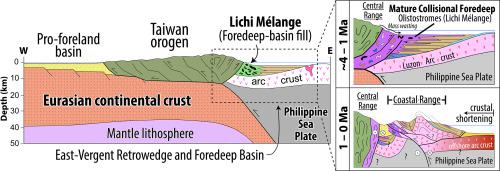Sedimentary Geology ( IF 2.8 ) Pub Date : 2021-03-23 , DOI: 10.1016/j.sedgeo.2021.105901 Larry Syu-Heng Lai , Rebecca J. Dorsey , Chorng-Shern Horng , Wen-Rong Chi , Kai-Shuan Shea , Jiun-Yee Yen

|
The Plio-Pleistocene Lichi Mélange in the Coastal Range of eastern Taiwan offers an excellent opportunity to study processes of mélange development at the continent-ocean interface of an active arc-continent collision. This paper presents new results of detailed geologic mapping, lithofacies analysis, magneto-biostratigraphy, paleocurrent, and paleoslope analyses in the southern Coastal Range to investigate the origins and significance of this mélange. The results show that the Lichi Mélange consists of mass-transport deposits including well-stratified block-in-matrix beds (olistostromes), extra-formational blocks (olistoliths), and broken formation with abundant soft-sediment deformation features that transition laterally into distal mega-slump beds and pebbly mudstones (subaqueous debrites). Abundant observations of depositional contacts and interbedding of mélange with contemporary (ca. 4–1 Ma) flysch units of the Fanshuliao and Paliwan formations confirm their sedimentary origin. Compacted sedimentological shear fabrics in olistostromal facies are broadly parallel to internal stratification and bedding, and are readily distinguishable from cross-cutting brittle fault zones related to post ~1 Ma west-vergent thrust faults. Paleoslope and paleocurrent analyses record down-slope gravity-driven transport toward the east and southeast.
The data provide evidence for a polygenetic origin of the Lichi Mélange, in which sedimentary mass-wasting deposits are overprinted by younger tectonic shear zones. Slide blocks, conglomerate clasts, and detrital sand were all derived from an eroding source in the east-vergent eastern retrowedge of the Taiwan collisional orogen. The source area included tectonically accreted fragments of the two converging plates that represent shallow-crustal equivalents of the Miocene Yuli Belt and Eastern Slates exposed in the modern Central Range. Reconstructed stratigraphic panels record eastward progradation of olistostromal facies over distal basinal flysch deposits, which we infer resulted from eastward (oceanward) migration of a steep submarine slope at the leading edge of the retrowedge orogenic front. Thus, the Coastal Range basin evolved as a migrating retro-foredeep basin that formed on top of older, pre-collisional volcanic arc and forearc crust. These results demonstrate a unique type of sedimentary basin that is formed and then rapidly inverted at a convergent continent-ocean interface during the transition from intra-oceanic subduction to arc-continent collision. This revised history of the Lichi Mélange provides a new perspective on the dynamics of rapid crustal mixing and tectonic recycling at the convergent suture of an active arc-continent collision system.


























 京公网安备 11010802027423号
京公网安备 11010802027423号